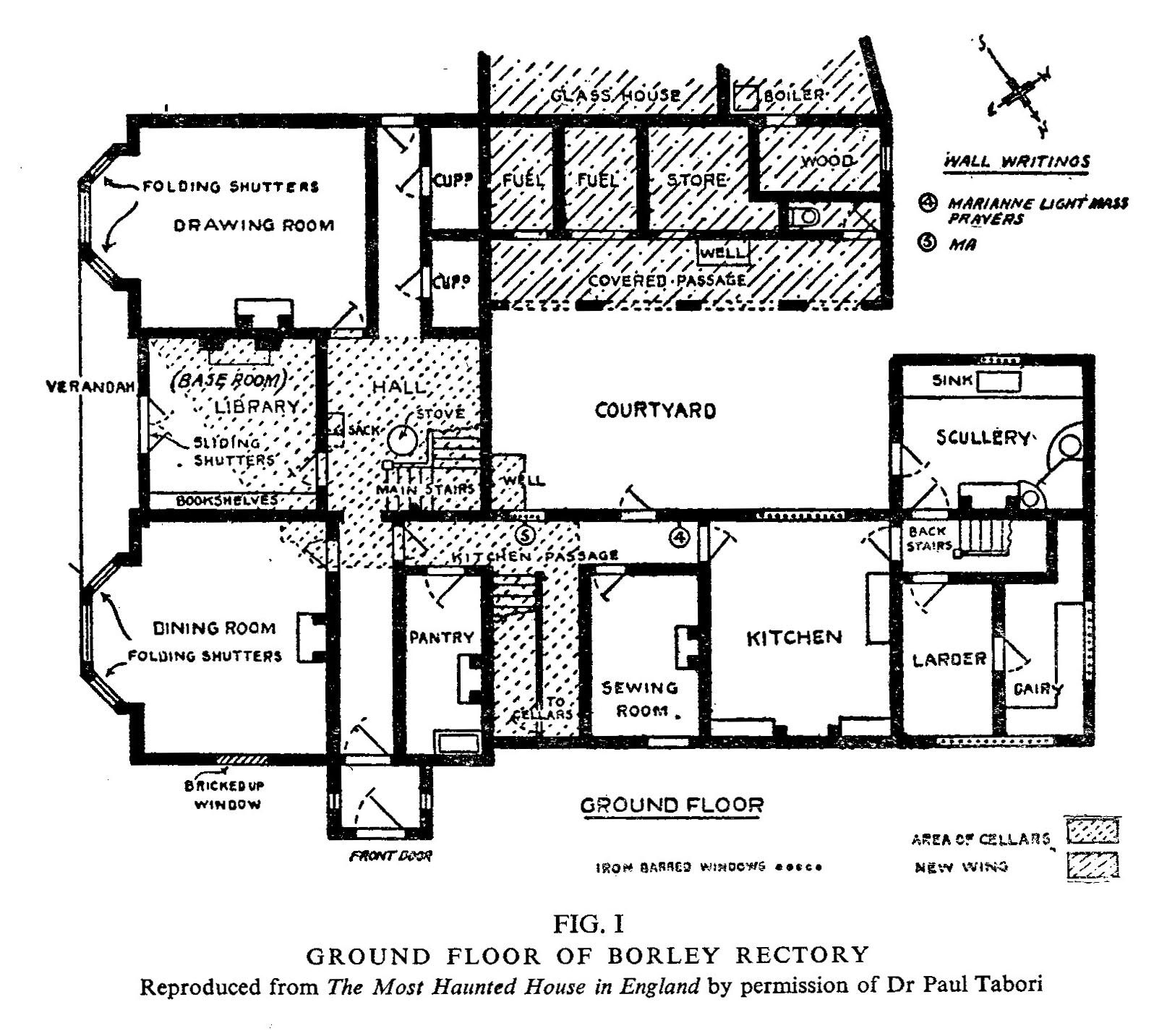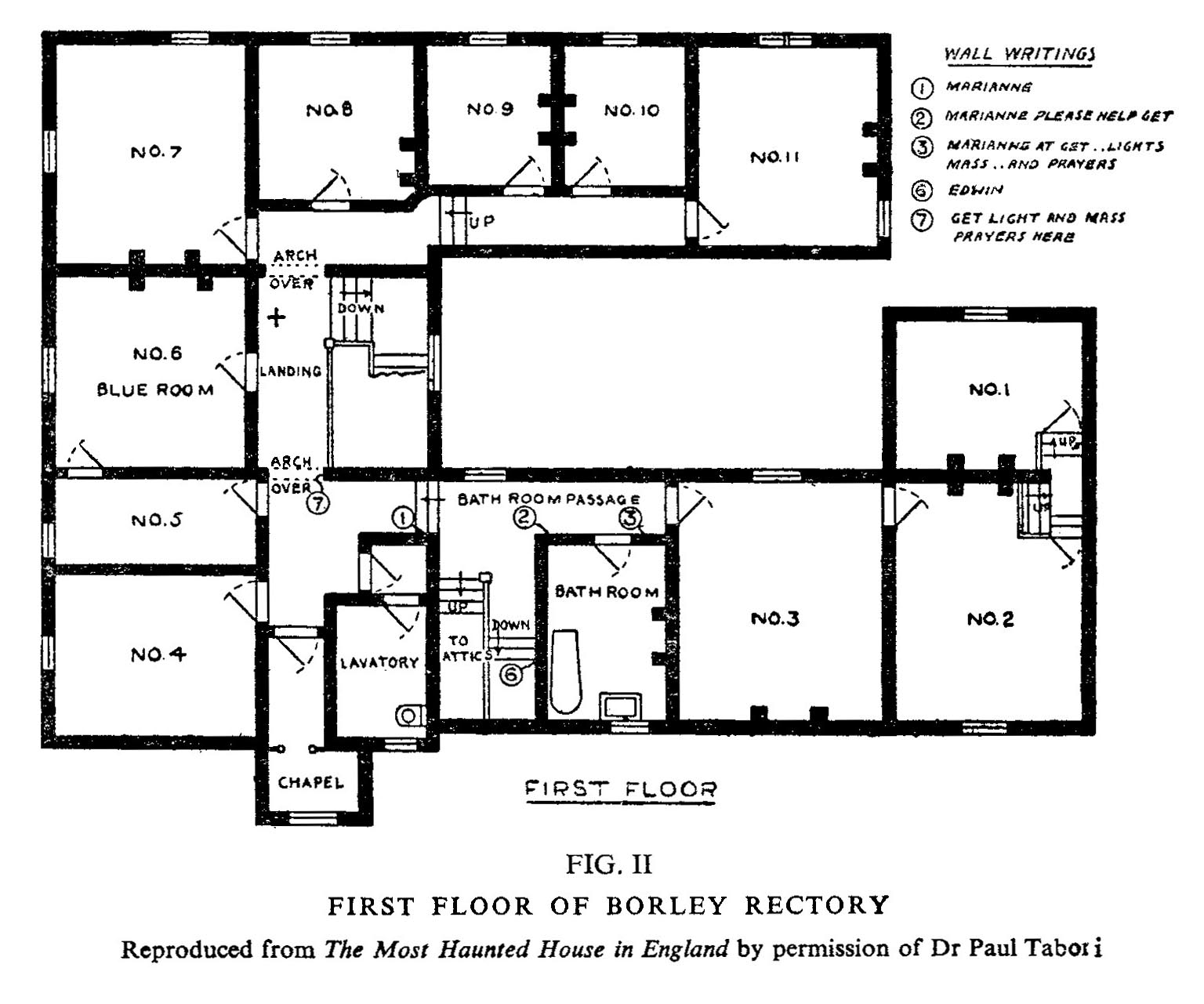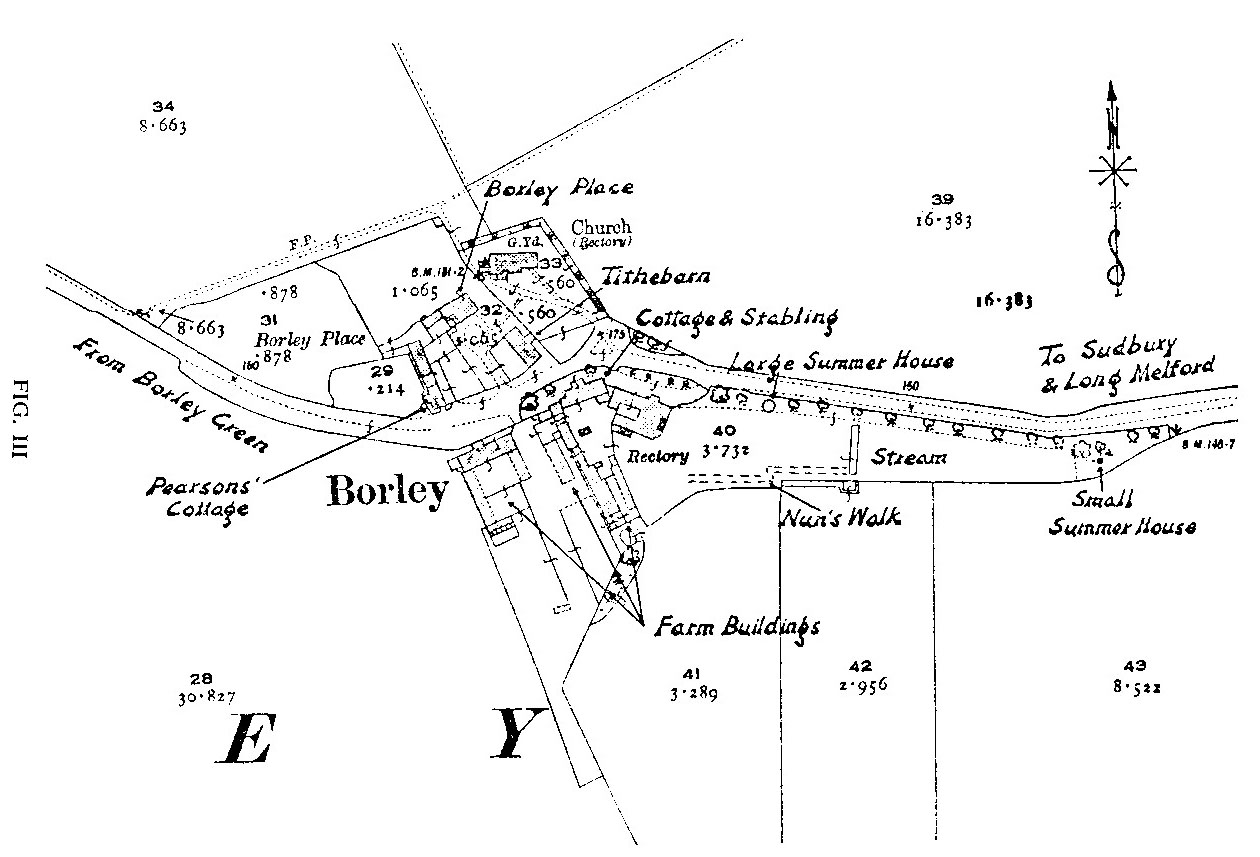|
Harry Price at Borley |
||||
|
|
Borley Church and the other buildings adjoining the site of 'the most haunted house in England' stand on a hill in Essex, less than a mile from and overlooking the valley of the River Stour (which forms the county boundary with Suffolk) and the single-track railway line between Long Melford and Sudbury. These two small townships are both in Suffolk and, although respectively 2 and 2½ miles distant, are distinctly visible from the elevated site of Borley Rectory. The grounds of the house (which was destroyed by fire in 1939) are situated on the road from Borley Green to Rodbridge Corner, the junction with the main highway from Bury St Edmunds to Sudbury. Borley parish itself has a scattered and mainly agricultural population of approximately 120 inhabitants. The position of the rectory and the buildings in its immediate vicinity is shown on Plate III which is a reduced photograph of part of the appropriate Ordnance Survey Sheet (edition of 1925) to a scale of 6" to one mile, and on Fig. III which is a reproduction of the 1/2,500 Ordnance map (1933 ed.) with added lettering showing principal buildings, etc. It may be noted that the considerable agricultural buildings grouped around the rectory farmyard in 1925 are also visible in an aerial photograph taken after the complete demolition of the rectory in 1944 (see Plate IV), and were therefore obviously standing during the whole period of the alleged hauntings. These farm buildings, which are not shown on the Key Plan on p. 21 of EBR, may be considered of some significance in connection with the presence of rats and mice in the rectory and its outbuildings and with sundry unpleasant odours noticed at various times. Another point of interest demonstrated by the Ordnance Survey plan is the extreme proximity of the cottage to the rectory and therefore to the very narrow entrance to the enclosed courtyard with its obvious acoustic properties, the evidence for which is discussed in detail in this report. The latter feature of the rectory is not shown on the small-scale Ordnance plan (Plate III) which was selected in order additionally to illustrate the position of the house in relation to Long Melford and Sudbury and to the railway joining them. The courtyard and its entrance are, however, clearly shown on the plan of the rectory ground floor (Fig. I). p.10 The rectory grounds, buildings, and farmyard contained 3.732 acres, of which approximately half consisted of the rectory garden with its long frontage to the road. What was in fact the side of the house (despite the fact that it contained the porch and main door) faced the road and was separated from it by a carriage drive with a gate at either end. A lawn extended from the eastern and principal elevation of the house with its bay windows and glass verandah to the stream shown in Fig. III, crossed by a miniature bridge which led to the extreme end of the garden and the copse containing the smaller of the two summer houses built by the Rev. Henry D. E. Bull. It was to this so-called 'Gothic' structure that the rector was said by Price (erroneously, we think) to retire in the small hours to commune with the spirits. The larger circular summer house adjoining the road, where both Henry Bull and his son Harry spent much time, is actually marked on the Ordnance Survey. The late Mr S. H. Glanville, who knew the house well and to whom we are indebted for much useful information, told us that the ring of tall trees surrounding the rectory and shown on the frontispiece of MHH had a very darkening and depressing effect inside the rooms. The rectory itself was built by the Rev. H. D. E. Bull in 1863 and was a large detached two-storey red brick building. A wing was added in 1875-6 almost entirely enclosing the small courtyard. With the kind permission of Mr S. H. Glanville (1) we are able to reproduce his original plans of the rectory showing the ground and first floors (Figs. I and II). The accommodation also included considerable cellaring and some storage accommodation in the roof. There were in all some 23 rooms, large and small, on the two main floors which were connected, be it noted, by three staircases. The house had no central heating, gas, or electricity and no main water supply. Immediately adjoining the house, as shown on the plan (Fig. III), was the rectory cottage, forming part of the original stable block which had the usual coach house, loose boxes, harness rooms, and living quarters above for the groom and his wife, and, as we have said, there were the agricultural buildings grouped around the former rectory farmyard. These latter were presumably included in that part of the 'nine acres' which 'formed the area of the original gardens, etc.,' and of which Price said that 'most of this has now been let off for farming purposes' (MHH, p. 24). The reader of the two Borley 1 Mr S. H. Glanville was the leading 'official observer' during Price's 1937-8 tenancy of Borley Rectory. He compiled a complete record of the rectory and its phenomena, a record known as the Locked Book from the fact that when bound it was fitted with a lock and key. Mr Glanville lent this Locked Book to Price, who used it in compiling MHH.
p.12 books will find little mention of the farmyard in Price's writings but traces are discernible here and there. Price reported, for example, that the phantom coach seen by Mr Edward Cooper 'swept into the farmyard and disappeared' (MHH, p. 55). Mr H. F. Russell told Price that the spot where he was unaccountably thrown to the ground was 'to the right of the plan you sent me and more in the entrance to the farm' (EBR, p. 67).
There are two principal legends connected with Borley Rectory which play their part in the story of the alleged hauntings. The first of these was the one published, apparently for the first time, in the Daily Mirror and other papers in June 1929, and was based on the assumption that the rectory was built on the site of a 13th-century monastery. This story was presumably current in the district for some time before its publication, and it has been suggested that it was established prior to the building of the rectory in 1863 and that the dining room fireplace with its monk's head effigies was installed by the Rev. Henry Bull to perpetuate a legend in which he may have believed. There are several variants of this first story, which we may loosely describe as the 'Monastery, Monk and Nun Legend', but in general terms the story is that some 700 years ago a monk from Borley Monastery eloped by coach with a novice from Bures Nunnery, some eight miles away. The legend says that the result of this ill-fated expedition was that the elopers were caught, the would-be bridegroom hanged or beheaded, and the novice bricked up alive in her own convent, which presumably accounts for the story of the phantom coach, the headless man, and the ghostly nun. Price points out on p. 22 of EBR that there is no evidence that a monastery ever existed at Borley and little evidence that there was ever a nunnery at Bures, but this view expressed by Price in 1946 was not always held by him, as we shall show in this report. There seems little doubt, in fact, from Price's early accounts of the Borley hauntings in the Journal of the American Society for Psychical Research in August 1929 and in his Confessions of a Ghost Hunter (London, 1936), that he accepted the legend of the previous existence of a large monastery at Borley until 3 November 1938 when this theory was exploded by Mr S. H. Glanville's patient correspondence with the Essex Archaeological Society, an official of which said that no ecclesiastical building other than the twelfth-century church had existed at Borley. That Price was at first reluctant to abandon this initial story of Borley, even in the face of the facts, is suggested by his letter to Captain W. H. Gregson some days later on 15 November 1938 in which he said:
FIG. III Reproduction (by permission of the Controller of H.M. Stationery Office) of 1/2,500 Ordnance map of Borley (1933 Edition) with added lettering showing principle buildings, etc. The proximity of the extensive farm buildings, omitted from the plans in the published literature, should be particularly noted.
p.14 'For the purpose of my book, I am trying to get details of what building, or buildings, were on the site of the Rectory before the present house was built. There is a persistent rumour that a monastery was very near the house, or rather the site and there are also tales of a nunnery being quite close.' However, common sense and the result of Mr Glanville's investigation must have prevailed. The second main story connected with Borley, which we may loosely describe as the 'French Roman Catholic Nun Legend', seems to have arisen in embryo from certain selected parts of planchette writings obtained by Miss Helen Glanville alone at Streatham on 28 October 1937, elaborated by further information obtained at a similar séance at Streatham three days later, at which the sitters were Mr S. H. Glanville, Miss Helen Glanville (his daughter), Mr R. H. Glanville (his son), and Mr M. Kerr-Pearse. From these séances and sundry chosen minutiae from the mass of alleged phenomena at Borley, an elaborate story was built up by Dr Phythian-Adams, Canon of Carlisle, and accepted with enthusiasm by Price. This is set out at length in Ch. X of EBR. The story in brief is that a young French Roman Catholic nun, Marie Lairre, was induced to leave her convent at Le Havre to become the wife of one of the Waldegraves of Borley and was strangled by him in a building previously on the site of Borley Rectory on 17 May 1667 and her body buried beneath the cellar floor. The suggestion was that the spirit of this unhappy young person was responsible inter alia for the rectory wall-writings, the loss of Mr Shaw Jeffrey's French dictionary, and the production of various 'apports', including two medals of somewhat suspicious provenance, an old coat, a piece of rotten wood, and a dead frog, in order to establish her identity and the whereabouts of her remains.
These, as we have said, are the two principal stories connected with Borley Rectory. There are other minor ones, such as the theory that the 'nun' was the ghost of Arabella Waldegrave, born in 1687, the daughter of Henry, first Lord Waldegrave. This suggestion was again at first accepted with enthusiasm by Price and was the subject of a lengthy exposition in his article 'The Ghost of Borley Rectory' (Everybody's Weekly, 7 August 1943). This story was, however, demolished in 1946 with Price's tacit approval by Dr Phythian-Adams in Ch. XVI of EBR. We have also the legend that Borley and, district may be haunted by the spirit of Simon of Sudbury, Archbishop of Canterbury, beheaded on Tower Hill on 14 June 1381 (MHH, p. 12). Then we have the story of the 'screaming girl' who, after supposedly clinging to the p.15 Blue Room (1) window-sill, crashed through the verandah roof and was killed, and whose spirit was alleged to haunt the rectory (MHH, p. 33). There is also the apparition of the Rev. Harry Bull, stated to have been seen repeatedly by Mrs Marianne Foyster (MHH, p. 75), and the figure of 'Old Amos', a gardener employed two hundred years previously by the Bulls, and whose phantom was recognised by the Rev. Harry Bull, although upon what pictorial record is not stated (MHH, p. 49). Miss Ethel Bull is stated to have seen the phantom of an old man wearing a tall hat beside her bed (MHH, p. 46). But after Price had received the exposition of the 'French Roman Catholic Nun' theory from Dr Phythian-Adams in January 1941 (EBR, p. 179), the secondary legends began to fade rapidly from the scene. There was after all, it seemed, no evidence to confirm the existence of Borley Monastery and its monks (EBR, p. 16) and on reflection Price doubted whether the ghost of Harry Bull had ever been seen at the rectory (EBR, p. 71). Simon of Sudbury and 'the screaming girl' do not appear in the pages of EBR, and the accounts of the 1937 table-tilting séances at Borley (EBR, pp. 120-32), which had concerned themselves almost solely with stories connected with the Bull incumbencies, were so ruthlessly edited as to be meaningless. Even a medal with what might popularly be described as a 'monk's head' on it, which Price recorded in the Journal of the American S.P.R. in August 1929 as having appeared in the rectory in July 1929, was apparently forgotten after the 1937 planchette scripts and, in its place, we are told that two quite different medals were 'apported' into the house, two medals which are mentioned nowhere in Price's files until they made their bow in MHH in 1940 (see pp. 61 ff). These medals supported the 'French Roman Catholic Nun' theory. The legend of Borley today is firmly interwoven with the story of Marie Lairre, and so far as we know she has now no serious rival. Her alleged wall-writings have even been investigated by a graphologist. Masses have been said for her repose in Oxford and Arundel (EBR, p. 288) and her alleged remains were given Christian burial in Liston Churchyard on 29 May 1945 (EBR, p.288).
This brief account of Borley and its legends would not be complete without some reference to the quite astonishing amount of regular newspaper publicity which the subject still attracts, despite the fact that almost the last remnants of the house were finally 1 Room No.6 on Fig. II. p.16 cleared away ten years ago. As this report goes to press (February 1955) we notice that during the years 1953 and 1954, under sensational headings such as 'GHOSTS STILL WALK AT BORLEY', 'BORLEY RELICS MAY HAVE RAISED GHOSTS', and 'CHICKEN HOUSE BLAZES WHERE HAUNTED RECTORY STOOD', Borley has been mentioned in the press on 91 occasions for which we have cuttings in our files, and there must be a very large number of references in various spiritualistic papers of which we have not been notified. The absurdity of some of these articles is, we think, exemplified by the suggestion that bricks from Borley buried under the turf of a school playing field at Wellingborough may be connected with the appearance of a ghost seen by one of the boys. Another favourite of ours hints darkly that the recent burning of a poultry-rearing house in Borley may be some sort of aftermath of the rectory fire in I939. Although the notoriety of Borley has largely arisen from Price's books, there can be no doubt that a considerable contribution has been made by the unrestrained press publicity which began in 1929 and has continued without interruption during the last 25 years. It will be part of our task in this report to discuss the implication of this publicity, and to assess its effect upon enthusiastic visitors to 'the most haunted house in England' or the site which it once occupied. p.17
Contents . Note & Preface . Diary of Events . I. Introduction . II. Topography & Legends . III. The Bull Incumbencies . IV. The Smith Incumbency & Harry Price . V. The Foyster Incumbency . VI. The Price Tenancy . VII. Later Borley . VII. Conclusions |
|||
|
The Base Room .
Biography .
Timeline .
Gallery .
Profiles .
Séance Room .
Famous Cases .
Borley Rectory .
Books By Price .
Writings By Price .
Books About Price .
Bibliography .
Links .
Subscribe .
About This Site All original text, photographs & graphics used throughout this website are © copyright 2004-2005 by Paul G. Adams. All other material reproduced here is the copyright of the respective authors. |


